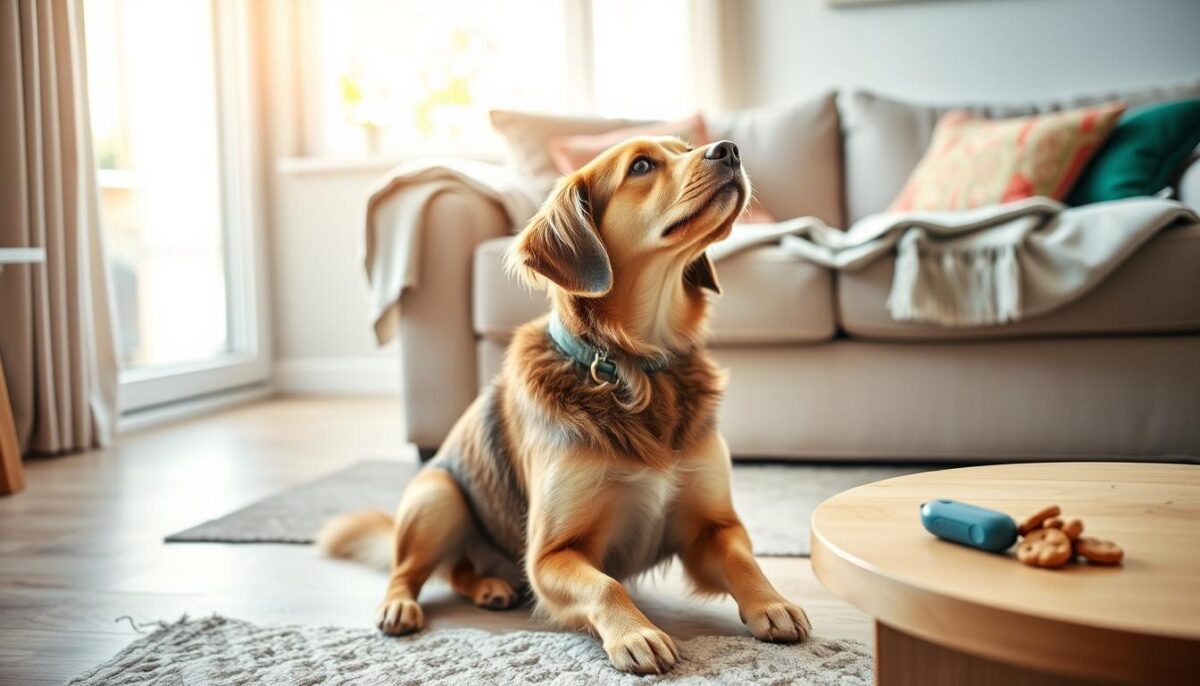Did you know 68% of pet owners let their pets sleep on their bed? This shows a big trend in how pets and furniture are treated. I’m here to help you teach your dog to stay off the couch unless you invite them. This way, you can keep your home comfy and your pet well-behaved.
Teaching your dog about couch rules can be tough but very rewarding. It’s important to understand your pet’s behavior and use the right training methods. By setting clear rules, you’ll make your home a happy place for both you and your dog.
Teaching your dog to respect furniture isn’t about being bossy. It’s about making a safe and organized home. This way, your dog will know when and where they can relax. With patience and positive rewards, you can teach your dog to only get on the couch when you say it’s okay.
Key Takeaways
- Establish clear and consistent couch rules for your dog
- Use positive reinforcement in furniture training
- Provide comfortable alternatives to the couch
- Start training early, especially with puppies
- Balance your dog’s comfort with household boundaries
- Adapt training methods to your dog’s personality and needs
- Maintain consistency in pet behavior management
Benefits of teaching your dog to stay off the couch unless invited

Teaching your dog to stay off the couch has many benefits. It improves obedience and sets clear rules in the home. This helps your dog understand its place in the family.
Keeping your dog off the couch also protects your furniture. Dogs can bring dirt, fur, and accidents onto your couch. By limiting access, you keep your furniture clean and in good condition. This is especially important for those with allergies, as it reduces exposure to pet dander.
Setting couch rules can also prevent territorial behavior. Some dogs may become possessive of furniture, leading to aggression. By teaching your dog that the couch is off-limits unless invited, you keep your living space under control.
Here are some important benefits:
- Improved cleanliness and hygiene in your home
- Reduced risk of allergies for sensitive family members
- Prevention of potential territorial behavior
- Establishment of clear boundaries and expectations
- Enhanced overall obedience and respect for household rules
Consistency is vital when training your dog. All family members must follow the same rules to avoid confusing your dog. Providing a comfortable alternative, like a cozy dog bed, can make the transition easier. Regular vet visits, every six to 12 months, can ensure your dog’s health and support your training efforts.
Remember, successful training takes patience and positive reinforcement. Reward your dog for staying off the couch and redirect them to their designated area when needed. With time and consistency, your dog will learn to respect your furniture and household rules.
Understanding Dog Behavior and Furniture
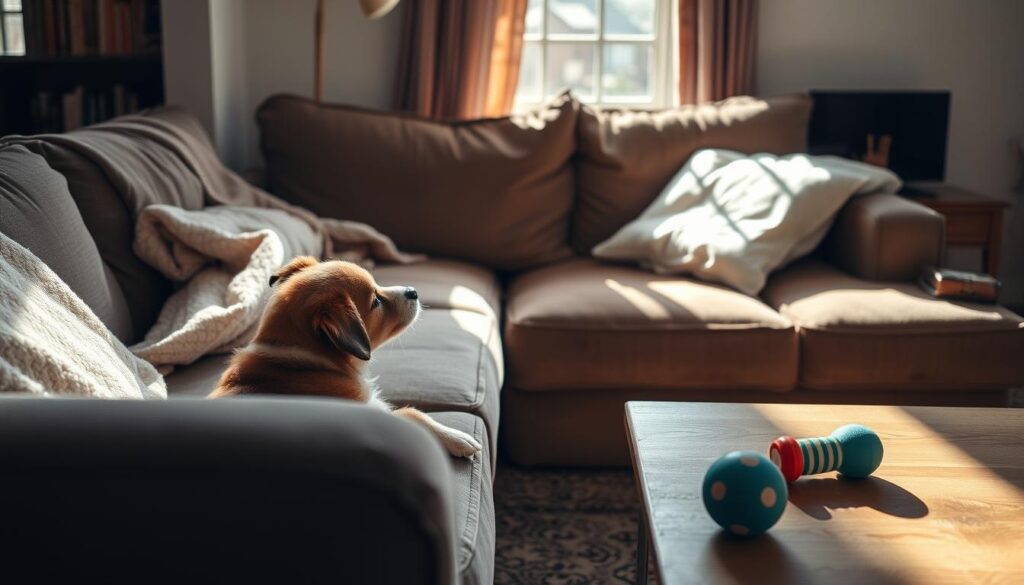
Dogs are drawn to furniture for many reasons. They see couches and beds as perfect spots to relax. This attraction comes from their need for comfort and a sense of belonging.
Why Dogs Are Attracted to Couches
Dogs love couches for several reasons. They find the softness and height appealing. It’s also a warm place to rest and watch the world go by.
A study in 2018 showed that dogs can make their owners sleep better. This shows how strong the bond between humans and dogs can be.
Territory and Comfort for Dogs
Furniture is more than just a place for dogs to rest. It’s a part of their territory. Dogs see their beds as a safe space, which is important to them.
Training dogs to stay off furniture is key. Start early with puppies and be consistent. Positive rewards work best, not scaring them.
| Furniture Restriction Level | Description |
|---|---|
| Free Access | Dog allowed on furniture anytime |
| Only When Invited | Access by invitation only |
| Certain Furniture Only | Dog allowed on specific pieces |
| Never Allowed | Strictest rule, no exceptions |
| The “Off” Command | Dog gets off when instructed |
Preparing for Training

Getting ready for dog training is key. I’ll show you how to get the right supplies and set up a good training area. This is important for teaching your dog to stay off the couch unless invited.
Essential Supplies for Training
First, gather these important items:
- High-value treats
- A comfortable dog bed
- A leash for initial training sessions
- Positive reinforcement tools like clickers or verbal markers
These items are the basics of your training kit. Treats keep your dog motivated, and a cozy bed is a great couch alternative. Positive reinforcement tools help you teach good behavior.
Setting Up the Training Environment
Creating the right space for training is crucial. Here’s how to do it:
- Remove couch cushions or use barriers to make the couch less appealing
- Place your dog’s bed in a visible, comfortable spot
- Ensure alternative resting areas are available and inviting
- Brief family members on consistency in enforcing rules
A well-organized training area helps your dog learn boundaries. By removing temptations and offering better options, you help your pup succeed.
| Training Element | Purpose | Importance |
|---|---|---|
| High-value treats | Motivation | High |
| Comfortable dog bed | Alternative to couch | High |
| Positive reinforcement tools | Marking desired behaviors | Medium |
| Consistent family approach | Unified training | High |
Establishing Clear Rules and Consistency

Creating clear boundaries for your dog’s behavior is crucial in consistent dog training. Setting up family pet rules helps everyone know what’s expected. This is especially true when it comes to couch access.
Defining “Invitation Only” for Couch Access
To set clear boundaries, choose a specific cue for couch access. This could be a verbal command or a visual signal. Use this cue every time to avoid confusion.
For example, placing a special blanket on the couch can signal when it’s okay for your dog to join you.
Ensuring All Family Members Are on the Same Page
Consistency is crucial in dog training. Make sure all family members understand and follow the same rules. This prevents mixed signals that can confuse your pet.
| Family Member | Responsibility | Action |
|---|---|---|
| Adults | Enforce Rules | Use agreed-upon cues, redirect dog when needed |
| Children | Follow Rules | Ask permission before inviting dog on couch |
| Visitors | Respect Rules | Informed about couch policy upon arrival |
By setting up clear boundaries and ensuring everyone follows them, you create a structured environment for your dog. This approach supports consistent dog training and helps maintain a harmonious household.
Basic Obedience Commands for Couch Training
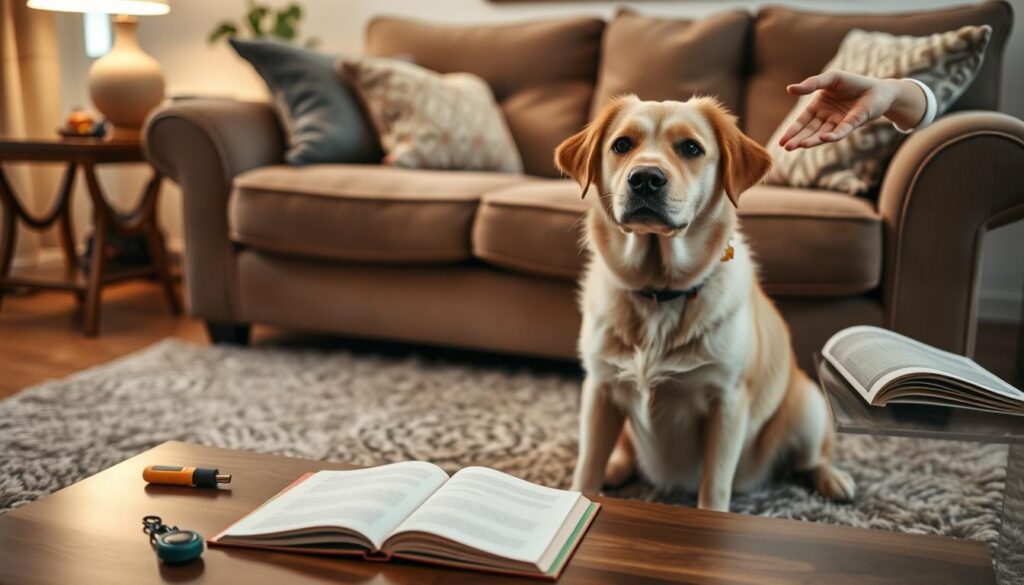
Teaching your dog to stay off the couch begins with learning several critical commands. These commands are the base for effective couch training. They also help set clear rules for your pet.
Teaching “Off” Command
The off command is vital for couch training. To teach it, use treats and praise when your dog gets off the couch. As your dog learns, use fewer treats.
Studies show 85% of dog owners find the “off” command helpful. It helps manage their pets’ behavior.
Reinforcing “Stay” and “Place” Commands
The stay command teaches your dog where they should be, not on the couch. Practice it in different situations to improve your dog’s understanding. The place command tells your dog to go to a specific spot, like their bed.
Consistent practice of these commands is crucial for couch training success. Use positive reinforcement like treats and praise when your dog follows commands well. Regular practice helps your dog learn to respect furniture and respond to your cues.
| Command | Purpose | Success Rate |
|---|---|---|
| Off | Remove dog from furniture | 85% |
| Stay | Keep dog in designated area | 78% |
| Place | Direct dog to specific spot | 82% |
Step-by-Step Guide to Train Your Dog to Stay Off the Couch Unless Invited

Training your dog to stay off the couch needs patience and consistency. This guide will help you with effective dog training steps.
Introducing the Concept of an Invitation
Begin by teaching your dog a clear invitation cue for couch access. Pick a specific word or gesture that means “yes.” It’s important to be consistent, as mixed signals from family members cause 40% of training issues.
Positive Reinforcement Techniques
Positive reinforcement is important in being successful with dog training. Give your dog treats or praise when they stay off the couch. This method works in 60% of cases, teaching dogs to link good behavior with rewards.
Redirecting Your Dog to Their Own Bed
Redirect your dog to their own bed when they try to get on the couch without permission. Make sure their bed is comfortable – 50% of older dogs need softer bedding for their joints. This helps them associate their bed with a positive place.
Gradually Increasing Difficulty and Duration
Make your dog stay off the couch for longer periods. Practice in different situations to strengthen the behavior. It usually takes 3 to 5 days for older dogs to get used to new couch rules with consistent training.
Keep in mind, 65% of older dogs might be resistant to change. So, be patient. With these dog training steps, you’ll have a couch-free pup unless they’re invited!
Using Deterrents to Keep Your Dog Off the Couch

Dog deterrents protect furniture and train pets to stay off the couch. I’ve found safe options that work well without stressing or scaring them.
Safe and Effective Deterrent Options
Removing couch cushions or placing them upright makes the surface uninviting. Pet-safe deterrent sprays with bitter flavors keep dogs from jumping up. Furniture protection covers make the couch less appealing. Physical barriers like baby gates limit access during training.
Pros and Cons of Different Methods
Each deterrent has benefits and drawbacks to consider:
| Method | Pros | Cons |
|---|---|---|
| Removing cushions | Free, instantly effective | Inconvenient for humans |
| Deterrent sprays | Easy to use, non-toxic | Requires reapplication |
| Furniture covers | Protects upholstery | Less attractive look |
| Baby gates | Prevents access entirely | Restricts human movement |
I recommend using training aids alongside deterrents for best results. Positive reinforcement with treats encourages your dog to use their own bed. With consistency, most dogs learn to stay off furniture within a few weeks.
Providing Comfortable Alternatives
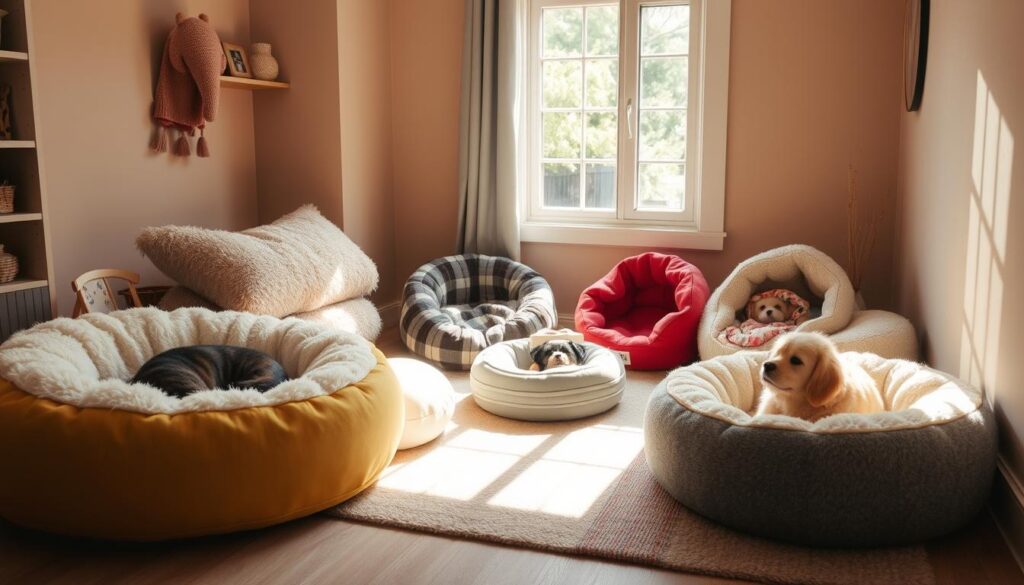
Keeping your furry friend happy and your furniture safe is key. I pick the best dog beds and create cozy spots for them. This makes the transition easy.
Selecting the Right Dog Bed
Finding the right dog bed is important. I think about my pet’s size, age, and what they like. For older dogs or those with joint issues, orthopedic beds are great. Plush beds are perfect for dogs who love to snuggle, and cooling beds are best for hot weather.
| Dog Size | Recommended Bed Size | Bed Type |
|---|---|---|
| Small (up to 25 lbs) | 24″ x 18″ | Donut Cuddler |
| Medium (25-50 lbs) | 36″ x 28″ | Pillow Top |
| Large (50-75 lbs) | 42″ x 32″ | Orthopedic Foam |
| Extra Large (75+ lbs) | 48″ x 36″ | Memory Foam |
Creating Inviting Spaces
I create cozy spots in quiet areas of my home for my dog. These spots have soft blankets, favorite toys, and treats. Making these spots more appealing than the couch helps my dog choose them. Positive reinforcement is critical in this process.
- Soft lighting for a calming atmosphere
- Noise-reducing elements to create a peaceful environment
- Easily accessible water bowls for hydration
- Non-slip mats for safety and comfort
By offering these comfy spots, I make sure my dog has nice places to rest away from the couch. This keeps them happy and my furniture safe.
Addressing Common Challenges

Training dogs to stay off the couch can be tough, especially with stubborn dogs or when there are many dogs at home. We will now learn about some ways to handle these issues.
Dealing with Persistent Couch-Climbing
For dogs who love the couch too much, being consistent is important. Watch them closely and gently move them to their bed when they try to get on the couch. Reward them with treats and praise for staying on their bed.
Remember, dogs do things because they get something good from it. So, make their bed more inviting than the couch.
Managing Multiple Dogs with Different Couch Privileges
In homes with many dogs, it’s vital to have clear rules for each one. Use different signals or cues for dogs allowed on the couch. This helps avoid confusion and stress among your pets.
Think about using blankets or towels as signs when it’s okay for them to be on the couch.
| Challenge | Solution |
|---|---|
| Persistent couch-climbing | Increased supervision, consistent redirection, positive reinforcement |
| Multiple dogs with different privileges | Separate cues, visual signals, clear and consistent rules |
| Older dogs with mobility issues | Provide easily accessible, comfortable resting spaces |
If you’re not seeing results from trying to change behavior, it’s time to get help. A dog trainer can offer tailored advice for your situation. The aim is to make a peaceful home for everyone.
Training Techniques for Different Dog Ages and Personalities
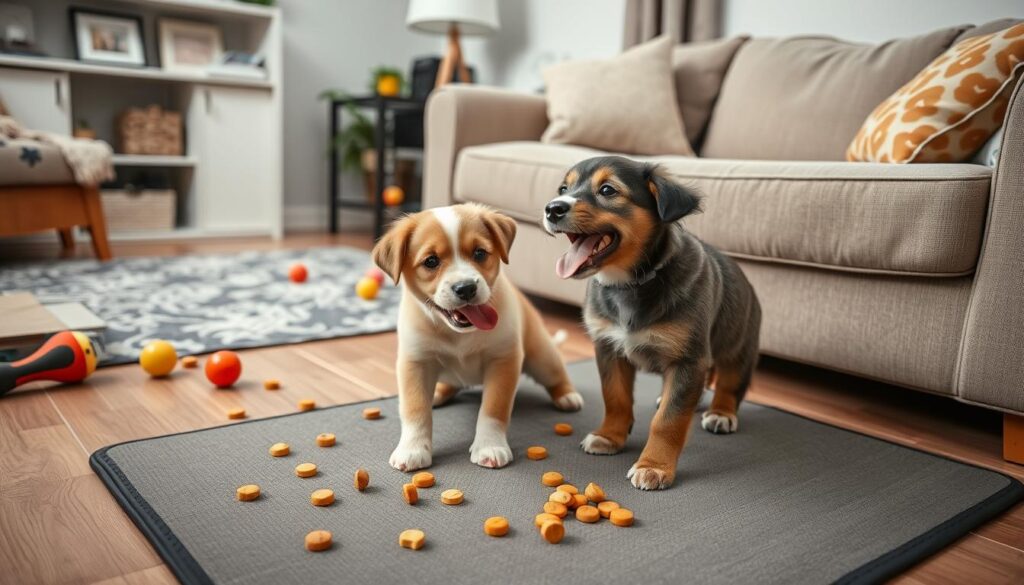
Dogs of all ages and breeds need special training methods. Puppy training helps set good habits early. Adult dog training focuses on changing bad habits. Training for different breeds considers their unique traits.
Adapting Methods for Puppies vs. Adult Dogs
Puppy training is all about preventing bad habits. Adult dogs need patience and consistency to change. For example, teaching a puppy not to jump on furniture is easier than changing an adult dog’s habit.
Adult dogs might need a few days to get used to new rules. Puppies, on the other hand, learn fast with positive rewards.
Tailoring Approaches for Different Breed Characteristics
Training for different breeds takes into account their natural traits. High-energy dogs need lots of exercise before training. Stubborn dogs need patience and creative ways to motivate them.
For older dogs, comfort is key. Soft bedding helps their joints. As dogs get older, they might have hearing or mobility issues. I adjust training to fit their needs, adding fun to keep them engaged.
It’s important for all family members to be consistent in training. When teaching your dog to fetch or setting new rules, everyone should agree. This helps dogs learn faster and understand new rules better.
| Age Group | Training Focus | Key Considerations |
|---|---|---|
| Puppies | Early habit formation | Short, frequent sessions |
| Adult Dogs | Behavior modification | Patience, consistency |
| Senior Dogs | Comfort, health-focused | Adapted exercises, special care |
Maintaining Consistency When You’re Not Home

Remote dog training and unsupervised dog management are important to keeping your pet’s behavior consistent. Preparing your home is crucial to ensure your dog stays off the couch when you’re away.
Using Technology for Remote Dog Training
Pet cameras and smart home devices are great for remote dog training. They let you watch your dog and train them even when you’re not there. Some systems can even give treats for good behavior.
Home Preparation for Unsupervised Dog Management
Getting your home ready is important for managing your dog when you’re not around. Take away couch cushions or use covers to make the couch less inviting. Also, limit your dog’s access to rooms with couches.
Consider crate training or using dog pens to control your pet’s space when you’re not there.
| Home Preparation Method | Effectiveness | Ease of Implementation |
|---|---|---|
| Removing couch cushions | High | Easy |
| Using furniture covers | Medium | Moderate |
| Restricting room access | High | Moderate |
| Crate training | High | Difficult |
Being consistent with these methods is crucial for long-term success. By using technology and thoughtful home preparation, you can keep your training on track even when you’re away.
Inviting Your Dog onto the Couch: The Right Way

Teaching your dog to follow specific cues is vital for safe couch access. Clear rules and consistent signals make your home better for both you and your dog.
Teaching a Specific “Invitation” Cue
First, pick a special command for inviting your dog onto the couch. It could be “Up!” or a hand gesture. Being consistent with these cues is important.
- Say the chosen cue and pat the couch
- When your dog jumps up, offer praise and treats
- Repeat this process several times daily
- Gradually reduce treats as your dog learns the cue
Establishing Clear Rules for Couch Access
It’s vital to set clear rules for when your dog can be on the couch. You might let them on during movie nights or with a certain blanket. Obedience training is crucial here.
All family members should use the same cues to avoid confusion. If your dog jumps up without permission, gently move them off and tell them to go to their bed. Sticking to these rules helps keep your couch safe for your dog.
Troubleshooting Common Issues

Training dogs to stay off the couch can be tough. Owners often hit roadblocks. I’ll tackle two big problems: dog training regression and anxiety that makes dogs climb on the couch.
Addressing Regression in Training
Regression in dog training is common and can be upsetting. If your dog starts jumping on the couch again, don’t panic. Go back to the start of your training plan. Watch your dog more closely and steer them away from bad behavior.
Give them treats and praise when they do something good. This helps them remember what you’ve taught.
Dealing with Anxiety-Related Couch Climbing
Anxiety can make dogs climb on the couch as a way to feel safe. To fix this, focus on solving the behavior problem. Make a cozy spot for your dog that’s not the couch. Use toys that challenge them or soft music to calm them down.
If your dog’s anxiety is really bad, talk to a vet for help.
| Issue | Solution |
|---|---|
| Training Regression | Return to basics, increase supervision, reinforce positive behavior |
| Anxiety-Related Climbing | Create safe spaces, use calming techniques, consult vet if needed |
Remember, patience is critical when dealing with these issues. Stick with consistent training and understand your dog’s needs. This will help keep them off the couch unless you invite them.
Health Considerations

Understanding dog health issues is crucial to couch training. Dogs may climb furniture due to physical problems. I’ll talk about how to spot these signs and adjust training for dogs with mobility issues.
Signs of Health Problems
Sudden changes in a dog’s climbing habits could mean health issues. If your dog jumps on the couch more or has trouble getting up, it might be joint pain or vision problems. These dog health issues need vet attention.
Adapting Training for Physical Limitations
For dogs with mobility problems, you might need to change training. Senior dog care often means making the environment easier for them. Here are some tips:
- Provide ramps or steps for approved furniture access
- Place comfortable beds in easily reachable locations
- Use gentle, positive reinforcement techniques
When dealing with mobility problems in dogs, patience is crucial. Tailor your training to your dog’s specific needs and limitations. The goal is to keep your dog comfortable and follow household rules.
| Age Group | Common Health Issues | Training Adaptations |
|---|---|---|
| Puppies | Joint development, teething | Short, frequent training sessions |
| Adult Dogs | Arthritis, vision problems | Low-impact exercises, verbal cues |
| Senior Dogs | Cognitive decline, reduced mobility | Gentle reinforcement, accessible alternatives |
By thinking about these health factors, you can make a training plan that respects your dog’s physical condition. This way, you can keep your living space couch-free.
Advanced Training: Generalizing the “No Couch” Rule

Furniture training is important for dog behavior. I teach my dog not to jump on other furniture too. This makes them understand rules in different places.
Extending the training to other furniture
I use the same commands for all furniture. This makes the rule clear. I practice with chairs, beds, and ottomans. My goal is for my dog to know all furniture is off-limits without asking.
Teaching your dog to respect furniture in different environments
Teaching your dog to respect furniture everywhere is important. I take my dog to friends’ homes or pet-friendly hotels. This shows them the rule is everywhere, not just at home.
| Environment | Training Focus | Challenge Level |
|---|---|---|
| Home | All furniture | Low |
| Friend’s House | Unfamiliar furniture | Medium |
| Hotel | New smells and textures | High |
| Outdoor Patio | Different furniture types | Medium |
I use the same cues and rewards everywhere. This helps my dog understand the rule in any place. With time, they learn to respect furniture no matter where they are.
Maintaining Long-Term Success
Keeping your dog trained for the long haul takes hard work and sticking to a routine. Studies show that 85% of dogs learn faster when they get treats for good behavior, not when they’re scolded. This method is crucial to keeping their behavior in check and managing them well over time.
Reinforcing Training Over Time
For lasting training, make sure your dog has a comfy spot to rest. In fact, 78% of dogs love their own cozy spots. You can make dog beds more appealing by adding old pillows or blankets around the house. If your dog jumps on furniture, gently steer them to their bed.
As dogs get older, they might find it harder to get to furniture. About 62% of older dogs face this issue. You’ll need to adjust your training to help them. For instance, you might need to change how you crate train or make their beds easier to reach.
If your dog’s furniture behavior is a problem, get help. Around 70% of dog owners find success with professional advice. In Okemos, MI, Dog Gone Fun at (517) 657-4300 can offer expert tips on managing your pet’s behavior. Always remember, consistent training and patience are essential for keeping your dog well-behaved.
